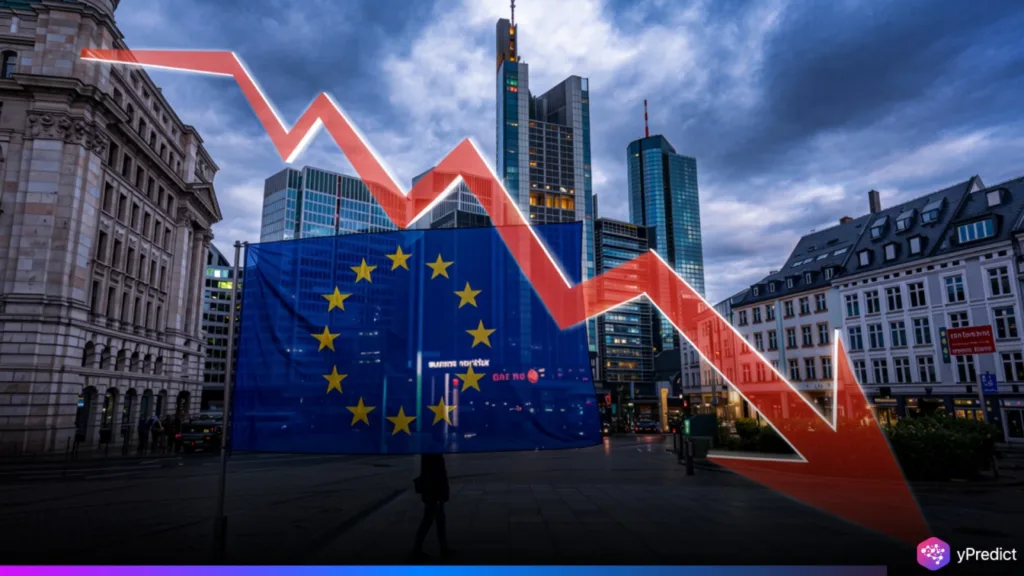
European stock markets showed remarkable stability on Thursday after the European Central Bank (ECB) enacted a widely anticipated interest rate cut, its first since 2019. The ECB rate cut, aimed at supporting growth amid slowing inflation, marks a pivotal moment in the eurozone’s monetary strategy.
With inflation easing toward the ECB’s 2% target, the rate cut signals a shift from the aggressive tightening cycle that began in 2022. Investors responded calmly, as markets had largely priced in the decision, and attention now turns to future guidance from ECB officials on additional policy moves.
Policy Easing Reflects Cooling Eurozone Inflation
According to Reuters, European financial markets remained calm on Thursday after the European Central Bank followed through on expectations by lowering its key interest rate by 25 basis points, marking its second cut in three policy meetings. The decision brought the euro zone’s borrowing cost to 2%, reinforcing the bank’s easing stance.
Markets responded calmly to the European Central Bank’s widely anticipated rate cut, with the euro edging up to $1.1019 and the German 10-year bund yield rising slightly to 2.124%. The STOXX 600 index advanced 1.1%, bolstered by a 1.8% gain in eurozone banking stocks. Earlier in the day, investor sentiment had already been buoyed by weak U.S. economic data that triggered a global bond rally and nudged Wall Street toward bull market territory.
Optimism in Europe was further reinforced by stronger-than-expected German industrial orders and the rollout of a domestic tax relief package, driving the STOXX 600 higher for a third consecutive session.
With the rate cut largely priced in, investor focus has shifted to ECB President Christine Lagarde’s forward guidance. Markets are watching for signals on future policy moves, especially as eurozone inflation nears the 2% target, U.S. trade talks remain unresolved, and German economic data shows unexpected resilience.
Additionally, Geopolitical tensions remained a key market driver as U.S. tariffs on steel and aluminum imports took effect, targeting Canadian and Mexican exports. Simultaneously, the White House pressed other trading partners for last-minute concessions to avoid additional levies set for July.
Market Response: Stability Reflects Confidence
Currency and commodity markets remained subdued as traders awaited clearer economic signals. The dollar index edged up 0.1% to 98.8, partially recovering from earlier losses. The greenback gained 0.3% against the yen to 143.34 and rose 0.25% versus the Swiss franc, while staying mostly flat against the euro and the British pound.
Muted trading followed a previous session of dollar weakness triggered by softer U.S. employment and services data, which heightened anticipation for the upcoming non-farm payrolls report. U.S. Treasury yields also declined, with the 10-year falling to 4.385% and the 30-year to 4.911%, both retreating from recent highs.
In Asia, investor sentiment was more upbeat. The MSCI Asia-Pacific index (excluding Japan) rose 0.7%, with South Korea’s KOSPI reaching its highest level in 11 months, bolstered by optimism around President Lee Jae-myung’s new administration. Hong Kong’s Hang Seng Index also climbed 1%.
In commodities, spot gold dipped 0.1% to $3,374 per ounce, trimming earlier gains. Oil prices remained steady, with Brent crude up 0.4% to just over $65 a barrel, following a rise in U.S. inventories and Saudi Arabia’s move to lower July prices for Asian buyers.
Conclusion
Despite weak U.S. PMI data and a cautious Chinese outlook, investors remain optimistic, banking on policy support and potential trade deals to sustain market momentum. The All Country World Index recently hit a record high, even as economic data signal fragility.
However, uncertainties remain, foremost among them is the threat of stagflation, which occurs when GDP slows as inflation increases. With central banks remaining cautious and fiscal measures gaining pace, the near-term market picture may be determined by the forthcoming corporate earnings season, which begins in mid-July.







